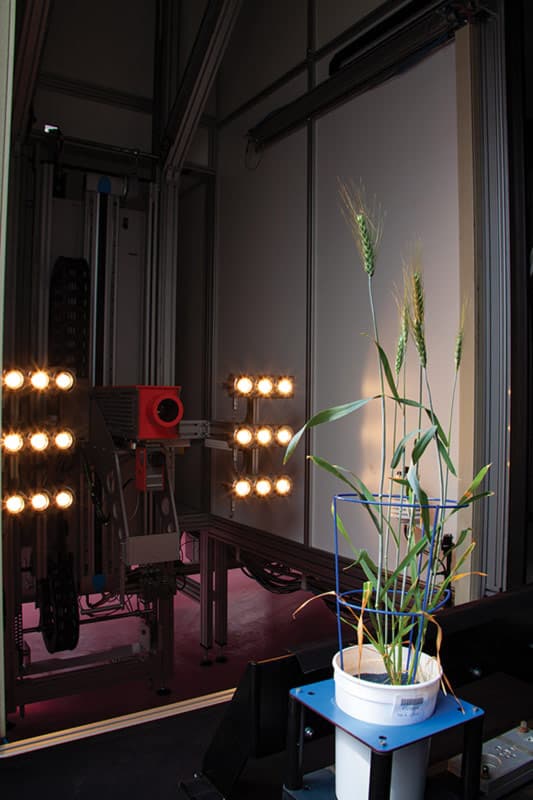 Australia
Australia
October 15, 2019

 Brooke Bruning at the hyperspectral plant imaging station located at the end of a conveyer belt that moves potted wheat plants through The Plant Accelerator®, Australian Plant Phenomics Facility. PHOTO Randy Larcombe
Brooke Bruning at the hyperspectral plant imaging station located at the end of a conveyer belt that moves potted wheat plants through The Plant Accelerator®, Australian Plant Phenomics Facility. PHOTO Randy Larcombe
Using light as a non-destructive analytical tool – both in the paddock to monitor crops and in the laboratory for trait discovery work – is a rapidly advancing area of technology development.
At the GRDC-sponsored Wheat Breeding Assembly, held in Adelaide in August, GRDC scholar Brooke Bruning spoke about her efforts to deploy advanced cameras into pre-breeding efforts that are targeting traits of importance to the Australian grains industry.
Ms Bruning thinks that irrespective of which hardware is used, current capability is only scraping the surface of what this technology can do.
This work is underway at the Plant Accelerator, the Adelaide node of the Australian Plant Phenomics Facility, and involves analysing images from light that extends beyond the visible range – so-called ‘hyperspectral’ images.


The hyperspectral imaging system at The Plant Accelerator, Australian Plant Phenomics Facility, Adelaide with the Specim SWIR camera sitting above the smaller SpecimFX10 camera. PHOTO Udo Seiffert
The aim is to use hyperspectral images as a way to interrogate plant physiology and, therefore, more rapidly and accurately phenotype breeding material.
Ms Bruning, who is in the final year of her PhD at the Waite campus of the University of Adelaide, has been particularly focused on light reflectance signatures related to the water and nitrogen content of plants.
Lighting the way
Capturing the required information requires the use of hyperspectral cameras that are not restricted to the visible range of light, which has a wavelength of about 350 to 700 nanometres (nm).
Instead, imaging is extended into the near infrared (700 to 1000 nm) and on to the shortwave infrared (1000 to 2500 nm).
The cameras used in this work are the SpecimFX10 (400-1000nm) and the Specim SWIR (1000-2500nm), which are commercially available for industrial, agricultural and laboratory use.
“The hyperspectral cameras capture a lot of information at a fine spectral resolution – too much information, in a sense,” Ms Bruning says.
“In terms of getting this technology adapted for use in agriculture, the main task is to tease out the irrelevant information so that we can identify the wavelengths that reveal the status of important traits.”
The hyperspectral cameras capture a lot of information at a fine spectral resolution – too much information, in a sense. – GRDC scholar Brooke Bruning
Teaming with AI
These days, that kind of data sorting and mining requires the use of advanced computing, including the extraordinary pattern recognition capability of artificial intelligence (AI) algorithms and neural networks (machine learning).
During her PhD, Ms Bruning has worked-up computer models that can translate image-based information into measurements of water and nitrogen content, as well as salinity stress levels in the leaves of wheat grown in pots.
“What we are seeing is that the hyperspectral cameras have phenotyping applications in which they are used to score a population relative to an important trait, such as salt status, by providing repeatable and unbiased measurements,” she says.

Computer algorithms are used to convert spectral information in hyperspectral images into predictions of plant physiology. PHOTO/GRAPHIC Brooke Bruning.
The hyperspectral cameras are a complementary technology to the hyperspectral reflectance device used in other Australian laboratories (see GroundCover™ issue 136).
Both use light to interrogate and classify plant physiology. However, the reflectance device, unlike the camera, is not an imaging tool but makes point measurements from light reflected off the surface of a leaf.
Ms Bruning thinks that irrespective of which hardware is used, current capability is only scraping the surface of what this technology can do.
Fast forward
Looking forward, Ms Bruning is keen to enhance imaging capability by pushing beyond merely identifying associations between spectral signatures and plant physiology. She wants to understand the reasons for those associations.
One approach she wants to pursue is to image at finer spatial resolution in order to associate spectral signatures with microscopic structures of leaves.
“With this technology, we are definitely seeing the potential to change the way plants are analysed for trait discovery work,” she says.
“But the exciting part of this technology is that once the mechanisms and processes behind the reflectance properties are identified, there are applications in crop monitoring in the paddock.
“That means that grain growers, too, can benefit from this technology.”
While reflectance technology to detect plant nitrogen is already driving efficiencies in the paddock through precision agriculture, Ms Bruning believes this technology will continue to roll out to grain growers, eventually to scale up to canopy-level analysis using aircraft or field platforms.
“With this imaging technology, we are ultimately changing the basis for assessing, screening and selecting for both varietal traits in pre-breeding programs and crop management practices in the paddock,” she says
More information: Brooke Bruning, brooke.bruning@adelaide.edu.au
Article by: Dr Gio Braidotti, GRDC, GroundCover
The APPF is an NCRIS-enabled facility offering open access to affordable fee-for-service research facilities, plant phenotyping technology and expertise to Australian and international academic and commercial researchers. From pilot tests and one-off research projects in controlled environments, to large-scale, long term research projects in the field, our multi-disciplinary team can provide the technology, data management and expertise you need to help answer your research questions. Contact us for more information on how we can help you.